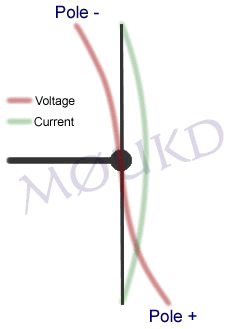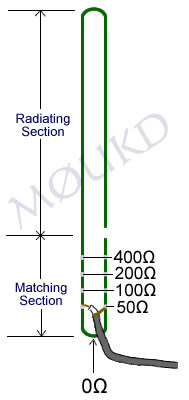The Slim Jim can be a great portable ‘roll up’ antenna, if made out of 300Ω or 450Ω ladder line / twin feeder. Add a loop of string to the top, and hang it on a tree branch, use it with your handheld transceiver, then roll it up and put it in your pocket when done! A Slim Jim for 2m (145MHz) will be 1.5 metres long, and 70cm (433MHz) will be 0.5 metres. Alternatively, for permanent installations, the copper tube or aluminium J-pole is a good choice. I have had good success with both, but regularly use the balanced feeder Slim Jim mounted on a 9m fibreglass pole, as can be seen in the photo at the bottom of the page.
It is recommended to use some sort of choke at the feedpoint. Around 6 close turns (for VHF) of the coaxial cable around a 40mm former (PVC pipe etc), or taped up and hung freely should be enough. I have also used a clip on ferrite for VHF. As with any balanced feed antenna, this will help prevent the braid of the coaxial cable from radiating, and becoming part of the antenna, and therefore affecting SWR and performance. The 6 turns is tested as adequate for VHF operation (145MHz) More may be needed lower down in frequency.
The spacing between elements, I have shown as 45mm on 2 metres. This is not critical. It will have some effect on where the 50Ω feed point is, but i’m sure you’ll find it! ‘D’ and ‘F’ work together in the calculations above. The critical lengths are B, C, and E then adjust the feedpoint to find a perfect match. Ignore B and E if building the "J pole".
*Velocity Factor: I have added the ability to select the velocity factor of your conductor. It is set by default to 0.96, which is for bare copper or bare aluminium. If you use balanced feeder such as 300Ω or 450Ω, adjust it to 0.91 (or set to the cable manufacturers specification if available).
50Ω feed point: The 50Ω feed point varies between the Slim Jim and the J-Pole. A Slim Jim has a higher feed impedance, due to it being a ‘folded dipole’, therefore it will be lower down. I have included a 50Ω feedpoint value for both the Slim Jim and the J-Pole, however, it really is a starting point and should be adjusted up and down until you get a 1.1 SWR with your antenna. You could even use a 4:1 coax balun and feed it higher up the matching section.
I made one for 4m (70MHz) which is 3 metres long. The quarter wave matching section can be made horizontal, with the half wave radiator section vertical, 90° to it if space is an issue, although this will affect radiation pattern slightly. Just remember the whole antenna needs to be in the clear, away from any objects, especially conductive objects!
So, how does this thing work?
  |
The Slim Jim, similar to the J-pole, is in fact a half wave end fed dipole, in the Slim Jim’s case, an end fed folded dipole. As with all folded dipoles, the currents in each leg are in phase, whereas in the matching stub they in phase opposition, so little or no radiation occurs from the matching section. You may think how can you say this is a dipole, when its just one element? Well, contrary to popular belief, the dipole is so named because it has two electrical poles, not two physical poles. Wouldn’t that be a di-element!? Just like a magnet has two magnetic poles, a North and a South, we have two electrical poles, a Positive and a Negative. Being a half wave, there is always two opposite poles on the tips at each half cycle. Any half wave antenna is actually a dipole.
To help explain this, I have drawn on the left, what happens to the voltage on a half wave element during one cycle. You can see, there are 2 poles, one positive and one negative at each half cycle. Hence, ‘dipole’. As its a half wave element, the wave is opposite at each end. Unlike the full wave example on the right, where the wave will join up if you imagine placing it on top of itself.
Hopefully, this explains things, and shows that the Slim Jim is actually a half wave dipole. A dipole, is usually fed from the centre, where the impedance is about 70Ω. This provides a reasonable match to 50Ω coaxial cable, and is why the centre fed dipole is so widely used. A dipole can be fed anywhere along its radiator, for example, the windom is ‘off centre’ fed at the 200Ω point, and an end fed half wave will give a very high impedance of up to around 5000Ω.
|
|---|
 |
So, we are feeding this half wave antenna from a high impedance point, which needs to be matched to 50Ω
coaxial cable, and is where the ‘J Integrated Matching’ (JIM) quarter wave matching section (λ/4) comes in. With the Slim Jim, you have the option to select the exact impedance you want, typically 50Ω. With the centre fed dipole, you have an impedance of around 68Ω, and usually the antenna is slightly detuned, to bring it down to 50Ω. The matching section is just that, and does not radiate significantly. Radiation starts from the beginning of the half wave section, to the tip of the antenna, so although the whole antenna is 3/4λ long, it is just a half wave radiator. The matching section does radiate a very small amount, due to the impedance’s at the top of the matching sections being not identical. This is because one is open (where the gap is) and the other is the feed for the radiating section. This means the two waves don’t completley phase each other out, and therefore some small radiation will occur. This is no significant problem, they are both high impedance, high voltage, low current points.
The 50Ω point can be found once you have built the antenna to the correct dimensions. Have the antenna out in the open, then move the feedpoint up and down small amounts, and when a 1:1 SWR is found, fix them there. An example of what the different impedance points may look like are shown on the image to the left. The calculator above will give you a good starting point, although spacing between the elements, velocity factor and other differences will have an effect on where this actually is.
Although the antenna is a half wave end fed, it will perform better than a half wave ground plane, due to its lower angle of radiation.
|
|---|
Dave M0TAZ using a 450Ω feeder Slim Jim on 70MHz.
I hope this has been of help to you. If you decide to build this antenna, I’d like to know what you think of it. Please leave a comment! Thanks, 73 John.





No comments:
Post a Comment